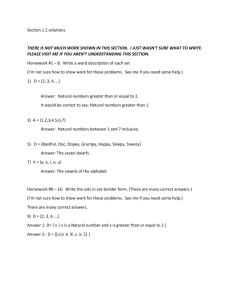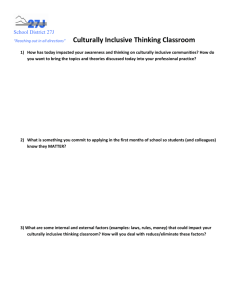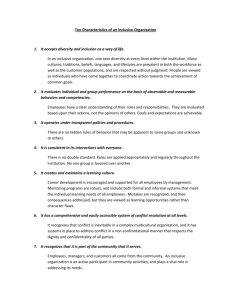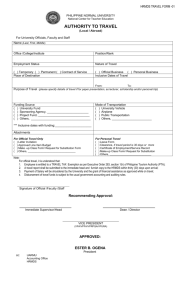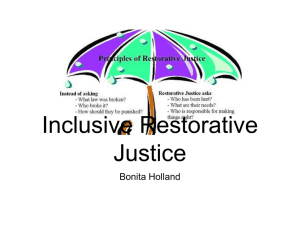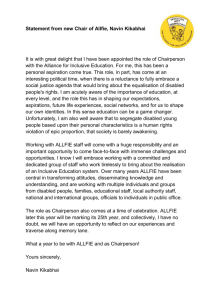Dr Geraldine O Neill
advertisement
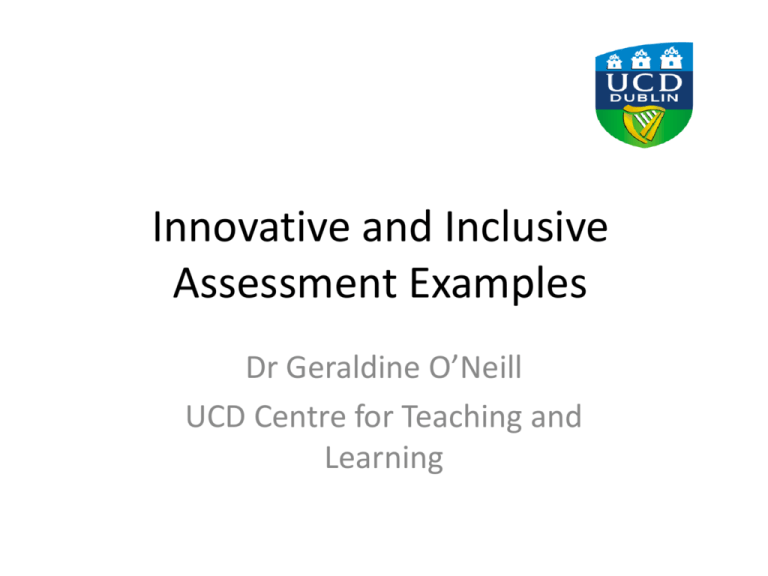
Innovative and Inclusive Assessment Examples Dr Geraldine O’Neill UCD Centre for Teaching and Learning What is Inclusive Assessment? Thinking about assessment and the students differently. http://www.edrobertscampus.org/images/ERC_front.jpg Inclusive Assessment Universal design refers to the design and composition of an environment so that it can be accessed, understood and used to the greatest extent possible by all people, regardless of their age, size or disability. (Disability Act, 2005) Disabled Students All Students Contingency Approach “special arrangements” such as extra time, own room, etc.) which is essentially a form of assimilation into an existing system Inclusive approach (e.g., a flexible range of assessment modes made available to all) capable of assessing the same learning outcomes in different ways. Alternative Approach (e.g., a viva voce instead of a written assignment) offering a repertoire of assessments embedded into course design as Innovation present and future possibilities for a minority of disabled students Systematic Innovation and Choice for all SPACE Project: http://www.plymouth.ac.uk/files/extranet/docs/SWA/1.%20Introduction.pdf Some innovative assessments examples (Nightingale et al, 1996; O’Neill, Huntley-Moore, Race, 2007) Thinking critically making judgements Performing procedures Critical Incident analysis Critical evaluation of research literature Critique of current concern Reflective Journal writing (Case No 11) Use of computer software Using video Objective Structured Clinical Assessment Mastery Assessment Self paced assessment of lab skills Solving problems/developing plans Managing/developing oneself Modified essay question Simulation Group Poster (Case No 18) Objective Structured Clinical Assessment Learning Contracts The Triple Jump Portfolios Self Assessment (Case No 24) Autobiography Reflective Journals Peer Assessment (Case No 13) Group/Individual Projects Peer Tutoring Some innovative assessments examples (Nightingale et al, 1996; O’Neill, Huntley-Moore, Race, 2007) Demonstrating knowledge/understanding Designing/creating Modified Tutorial Question Diagram Sheets Project Report/ Essay Multiple Choice Questions Test and Quizzes (Case No 21) Practical Exams In-class mini-tests (Case No 9) Design Projects Group Projects Authentic tasks (Case No 1) Participation in competition Design and Build project Learning Contracts Portfolios Accessing/managing information Communicating Library Research assignment (Case No 3) Self Assessment Schedule Developing a Data Base Peer assessment Design a web page Checklist Self Evaluation Portfolio On-line discussion (Case No 2) Assessing Class Participation Assessing a Formal Presentation Posters Public Displays One step further ‘Innovative’ and ‘Inclusive Assessment’ for All students MODULE ASSESSMENT CHOICE Learning Outcomes OR Assessment Criteria OR An Example: University of Plymouth (Eastbrook, Parker & Waterfield, 2005: SPACE project: http://www.engsc.ac.uk/downloads/pdfs/Resource/assessmentchoice.pdf) MODULE ASSESSMENT CHOICE Module: Behaviour of Structures (School of Engineering) End of Module Test (n= 146 students, 14 disabled students) Coursework or or Assessment Criteria Portfolio or Weekly test Move, not just to innovative, but to inclusive assessment References Barton, L. (2003) ‘Inclusive Education and Teacher Education – A Basis for Hope or a Discourse of Delusion’, Professorial Lecture, Institute for Education, University of London Brown, G., Bull, J., and Pendlebury, M. (1997) Assessing student learning in higher education. London, New York: Routledge. Elton, L. and Johnston, B. (2002) Assessment in Universities: a critical review of research Learning and Teaching Support Network (LTSN) Generic Centre: York Heywood, J. (2000) Assessment in higher education: student learning, teaching, programmes and institutions. London: Jessica Kingsley. Nightingale, P., Te Wiata, I., Toohey, S., Ryan, G., Hughes, C., and Magin, D. (1996) Assessing learning in Universities. Sydney: University of New South Wales Press. SPACE Project - Inclusive Assessment (2009) http://www.plymouth.ac.uk/pages/view.asp?page=10494 Accessed April 2009. Rose, D. and Meyer, A. (2000) ‘Universal Design for Learning’ Journal of Special Education Technology Volume 15 No. 1, Winter 2002 Stuart, M. (2005) ‘What price inclusion? Debates and discussions about learning and teaching to widen participation’, in Layer, G. Closing the Equity Gap. The impact of widening participation strategies in the UK and the USA NIACE: Leicester Talbot, C. (2004) Equality, Diversity and Inclusivity: Curriculum Matters (Staff and Education Association (SEDA) Special Number 16) SEDA: Birmingham Waterfield, J., West, R. and Parker, M. (2006) ‘Developing an Assessment Toolkit in Inclusive Learning in Higher Education’ in (Eds.) Adams, M. and Brown, S. Towards Inclusive Learning in Higher Education: Developing Curricula for Disabled Students Routledge: London

